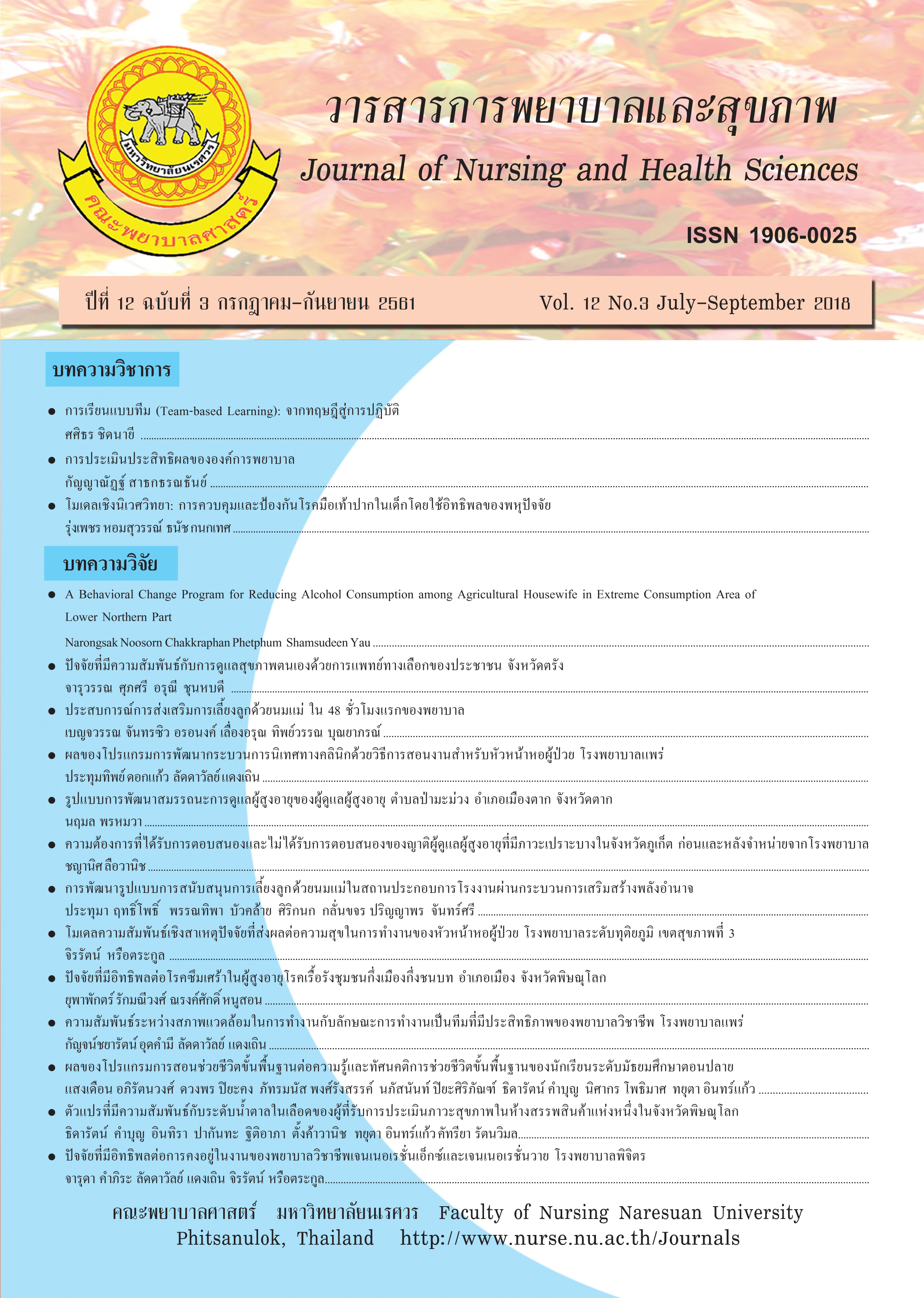การประเมินประสิทธิผลขององค์การพยาบาล
Main Article Content
บทคัดย่อ
ประสิทธิผลขององค์การเป็นสิ่งที่บอกได้ว่าองค์การนั้นมีการบริหารจัดการและประสบผลสำเร็จดี เพียงใด ความสามารถในการจัดองค์การและการใช้ทรัพยากรที่มีอยู่ให้เป็นประโยชน์บรรลุวัตถุประสงค์ มีผลสัมฤทธิ์สูงสุด และความพึงพอใจของผู้รับบริการหรือผู้มีส่วนได้ส่วนเสีย การที่จะบอกได้ว่าองค์การ มีประสิทธิผลดีเพียงใด ต้องมีเกณฑ์การประเมินผล ประสิทธิผลขององค์การโดยทั่วไปสามารถประเมิน ผลหรือวัดผลได้จากผลลัพธ์ของการปฏิบัติงาน หรือผลิตภาพในงาน การใช้ทรัพยากรอย่างมีประสิทธิภาพ การบรรลุเป้าหมายของบุคคล กลุ่มงานและองค์การ ความพึงพอใจของผู้รับบริการและของบุคลากร ในองค์การและคุณภาพของการบริการ สำหรับการประเมินประสิทธิผลขององค์การด้านสุขภาพ สามารถ ประเมินได้จากเกณฑ์วัดที่ผสมผสานแนวคิดทฤษฎีเชิงระบบกับแนวคิดเชิงเป้าหมาย ตัวชี้วัดของประสิทธิผล จึงเป็นผลลัพธ์ของแต่ละองค์ประกอบของระบบ คือ ปัจจัยนำเข้า-การดำเนินการ-ผลผลิต และการเลือกตัว ชี้วัดจึงจำเป็นต้องพิจารณาตามความเหมาะสม และวัตถุประสงค์ของการประเมินที่สามารถปฏิบัติได้จริง เช่น ผลผลิต คุณภาพ ความพึงพอใจ เป็นต้นองค์การพยาบาลเป็นหน่วยงานหนึ่งที่มีบทบาทหน้าที่ให้บริการ ในองค์การสุขภาพจึงจำเป็นอย่างยิ่งที่จะต้องมีการประเมินประสิทธิผลขององค์การ เพื่อประเมินผลการ ดำเนินงานขององค์การว่าบรรลุตามเป้าหมาย ประสิทธิภาพและประสิทธิผล หรือผลิตภาพขององค์การว่า ได้มาตรฐานตามที่องค์การกำหนดหรือไม่ ทั้งในด้านปริมาณและคุณภาพ เป็นที่พึงพอใจของผู้รับบริการ หรือไม่โดยที่ผลสำเร็จนั้นใช้ต้นทุนต่ำ สมาชิกทุกคนมีความพึงพอใจ และให้ความร่วมมืออย่างดี จนสามารถ สร้างผลิตภาพในงานอย่างต่อเนื่อง ผู้บริหารการพยาบาลจึงควรทำความเข้าใจให้ถ่องแท้ เพื่อให้สามารถ ประเมินประสิทธิผลองค์การได้ เพราะประสิทธิผลขององค์การเป็นสิ่งที่บอกได้ว่าองค์การนั้นมีการบริหาร จัดการและประสบผลสำเร็จดีเพียงใดหากองค์การพยาบาลจะประเมินประสิทธิผลของงานบริการพยาบาล ว่าสามารถบรรลุตามเป้าหมายที่กำหนดไว้หรือไม่ สามารถวัดได้จากผลลัพธ์ทางการพยาบาล (Nursing Outcome)ซึ่งอาจวัดได้จากตัวชี้วัด 3 ประการ ได้แก่ คุณภาพบริการพยาบาล ความพึงพอใจของผู้รับบริการ และความพึงพอใจในงานของบุคลากร
Article Details
เอกสารอ้างอิง
กระทรวงสาธารณสุขปีงบประมาณพ.ศ.2561.
นนทบุรี : สำนักงานปลัดกระทรวงสาธารณสุข.
กระทรวงสาธารณสุข. (2557). แบบวัดความพึงพอใจ
ในงานของบุคลากร. นนทบุรี : กรมการแพทย์.
บุญใจ ศรีสถิตย์นรากูร. (2550). ภาวะผู้นำและกลยุทธ์
การจัดการองค์การพยาบาล ในศตวรรษที่ 21.
กรุงเทพมหานคร : โรงพิมพ์แห่งจุฬาลงกรณ์
มหาวิทยาลัย.
วิภาดา คุณาวิกติกุล, วิจิตรศรีสุพรรณ, รัตนาวดี
ชอนตะวัน, เรมวล นันทศุภวัฒน์, อรพรรณ
พุมอาภรณ์ และโรเบิร์ตแอล แอนเดอร์. (2543).
การพัฒนาคุณภาพการพยาบาล.เชียงใหม่:
คณะพยาบาลศาสตร์มหาวิทยาลัยเชียงใหม่
ฟาริดา อิบราฮิม. (2542). สาระการบริหารการพยาบาล.
กรุงเทพมหานคร : โรงพิมพ์สามเจริญพาณิชย์
จำกัด.
สำนักการพยาบาล. (2547). ตัวชี้วัดคุณภาพการพยาบาล
ในโรงพยาบาล. พิมพ์ ครั้งที่ 1. กรุงเทพฯ :
โรงพิมพ์สามเจริญพาณิชย์ (กรุงเทพฯ) จำกัด.
สำนักการพยาบาล. (2547). ตัวชี้วัดคุณภาพการพยาบาล
ในชุมชน. พิมพ์ครั้งที่ 1. กรุงเทพฯ :โรงพิมพ์
สามเจริญพาณิชย์ (กรุงเทพฯ)จำกัด.
สำนักการพยาบาล. (2547).แนวทางการประเมินคุณภาพ
ภายนอก.กรุงเทพฯ: สามเจริญการพาณิชย์.
สำนักการพยาบาล. (2551). มาตรฐานการพยาบาล
ในโรงพยาบาล. พิมพ์ครั้งที่ 3. กรุงเทพมหานคร:
โรงพิมพ์องค์การสงเคราะห์ทหารผ่านศึก.
สำนักการพยาบาล. (2557). ข้อมูลสำคัญด้านการ
พยาบาล ประจำปีงบประมาณ 2557 : แบบวัด
ความพึงพอใจผู้ป่วยใน, แบบวัดความพึงพอใจ
ผู้ป่วยนอก. นนทบุรี :สำนักการพยาบาล.
สำนักการพยาบาล. (2561). แนวทางการจัดเก็บตัวชี้วัด
การพัฒนาคุณภาพบริการพยาบาล ประจำปี
งบประมาณ 2561. พิมพ์ครั้งที่ 1. ปทุมธานี :
บริษัท สำนักพิมพ์สื่อตะวันจำกัด.
อนุวัฒน์ ศุภชุติกุลและจิรุตม์ ศรีรัตนบัลล์. (2543).
คุณภาพของระบบสุขภาพ. นนทบุรี : สถาบันวิจัย
ระบบสุขภาพ.
Aday, Lu ann. & Andersen, Ronald. (1975). Development
of indices of access to medical care
(1sted). Michigan :Ann Arbor Health Administration
Press.
Benson, G. P., Saraph, J. V.,&Shchoreder, R. G. (1991).
"The effects of organizational context on quality
management : An Impirical investigation".
Management Science, 37(9), 1107-1124.
Campion, M.A., Medsker,G.J. &Higgs,A. C. (1993).
Relations between work group characteristics
and effectiveness : Implications for designing
effectiveness work groups. Personal Psychology,
46(4), 823-835.
Dean, E.(1996). "The perceived impact of team-based
management systems onorganizational
effectiveness". International Journal of
Manpower, 17(8), 417.
Donabedian, A. (1994). "Explorations in quality as
sessment and monitoring: The definition of
quality and approaches to its assessment".
In McClosky JC, Grace HK, eds. Current
Issues in Nursing, (4thed).St. Louis :Mosby-
Year Book.
Eriksen, L. R. (1987). Patient satisfaction :An indicator
of nursing care quality.Nursing Management,
18 (July,1987), 31-35.
Gaertner, G. ;&Ramnarayan, S. (1983). "Organizational
effectiveness : an alternative perspective."
Academy of Management Review.97-107.
Gibson, J.L., Ivancevich, J.M., &Donnelly,J.H. (1997).
Organizations behavior, structure, process.
New York :McGraw-Hill.
Gordon, J. R.,Mondy, W., Shaplin, A., &Premeaux,
S.(1990). Management and organizational
behavior. Boston :Allyn and Bacon.
Hackman,J.R., &Lawer, E.E. III.(1971). Emplooyee
reactions to job characteristics. Journal of
Applied Psychology Monoraph, 55(3), 259-286.
Hampton, G.M. & Hampton, D.L. (2004). "Relationship
of professionalism, rewards, market
orientation and job satisfaction among
medical professionals: The case of certified
nurse-midwives". Journal of Business
Research, 57(9), 1042-1053.
Hertz, H. S. (2002). Health care criteria for
performance excellence.Wisconsin Baldrige
National Quality Program, 200(2), 5-11.
Holzemer, W.L. (1994). The impact of nursing care in
latin America and the Caribbean : A focus on
outcomes.Journal of Advanced Nursing, 20(1),
5-12
Joint Commission on Accreditation of Healthcare
Organizations. (2003). The joint commission
on accreditation of healthcare organizations
revises standards for 2004. Journal of
Peri Anesthesia Nursing, 18(5), 352-357.
Mueller, C. W.& McCloskey, J. C. (1990).Nurse' job
satisfaction: A proposed measure. Nursing
Research, 39(2),113-117.
Risser, N. L. (1975). Development of Instrument to
Measure.Patient Satisfaction with Nurses and
Nursing Care in Primary Care Setting.Nursing
Research.24 (Jan-Feb.1975),45-51.
Rojas, R. R. (2000). A review of Models for Measuring
Organizational Effectiveness among for
profit and nonprofit organizations, nonprofit
Management & Leadership, 11(1), 97-104.
Sanger, E., Richardson. J. & Larson, L. (1985). What
Satisfies Nurses Enough to Keep Them?.
Nursing Management: September.16 (9) 43-46.
(online) Available : https://journals.lww.com/
nursingmanagement.
Slavitt, D.B., Stamps, P.L.,Piedmonte, E.B., &
Haase,A.M. (1978) "Nurse' satisfaction with
their work situation". Nursing Research, 27,
14-120.
Stamps, P.L., &Piedmonte,E.B., (1986). Nurses and
work satisfaction. Michigan :Health Administration
Press.
Tribodeaux, M.S. &Favilla,E. (1996). "Organizational
effectiveness and commitment through
Strategic management". Industrial management
and data systems, 96(5), 1-5 (online) Available
: http://www.emerald.com.
Spector, P. E. (1985). Measurement of human service
staff satisfaction:Development of the job
satisfaction survey. American Journal of
CommunityPsychology, 13, 693-713.
Weiss, D. J., Dawis, R. V., England, G. W. &Lofquist,
L. H. (1967). Manual for The Minnesota
Satisfaction Questionnaire. The University
Computer Center, University of Minnesota.


